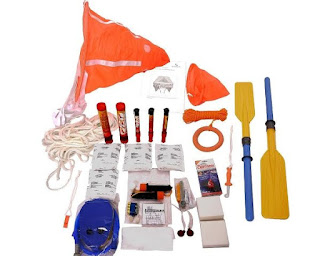what are the 3 types of visual distress signals?
Red Hand Flare
A hand flare is a small stick which when activated, produces an intense red smoke or light without an explosion.
The hand flare shall:
The hand flare shall:
- be contained in a water-resistant casing;
- have brief instructions or diagrams clearly illustrating the use of the hand flare printed on its casing;
- have a self-contained means of ignition; and
- be so designed as not to cause discomfort to the person holding the casing and not endanger the survival craft by burning or glowing residues when used in accordance with the manufacturer’s operating instructions.
The hand flare shall:
- burn with a bright colour;
- burn uniformly with an average luminous intensity of not less than 15,000cd;
- have a burning period of not less than 1 min,; and
- continue to burn after having been immersed for a period of 10 s under 100 mm of water.
Rocket parachute flares
As the name suggests, the equipment has a flare which is launched at minimum height of 300m in the air, where it self-activates to produce intense red smoke. A parachute opens up and reduces the rate of decent which gives more time to the flare to remain at a height and to provide a clear view to nearby ships or help.
The rocket parachute flares shall;
- be contained in a water flares shall
- have brief instructions or diagrams clearly illustrating the use of the rocket parachute flare printed on its casing
- have integral means of ignition ;and
- be so designed as not to cause discomfort to the person holding the casing when used in accordance with the manufacturer’s operating instructions.
The rocket shall, when fired vertically, reach an altitude of not less than 300m, At or near the top of its trajectory, the rocket shall eject a parachute flare, which shall:
- burn with a bright red colour;
- burn uniformly with an average luminous intensity of not less than 30,000cd;
- have a burning period of not less than 40s;
- have a rate of descent of not more than 5m/s; and
- not damage its parachute or attachments while burning.
Buoyant smoke signals
This pyro tech equipment is held in compact container with a buoyant nature so that it can float on the water surface to signal distress situation.
Buoyant smoke signals shall:
- be contained in a water-resistant casing;
- not ignite explosively when used in accordance with the manufacturer’s operating instructions; and
- have brief instructions or diagrams clearly illustrating the use of the buoyant smoke signal printed on its casing.
The buoyant smoke signal shall:
- emit smoke of a highly visible colour at a uniform rate for a period of not less than 3 min when floating in calm water;
- not emit any flame during the entire smoke emission time;
- not be swamped in a seaway ; and
- continue to emit smoke when submerged in water for a period of 10 s under 100mm of water.



Comments
Post a Comment